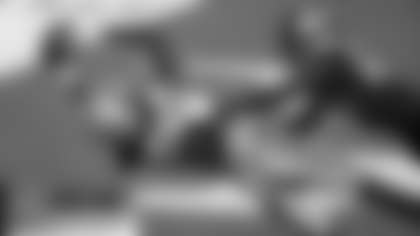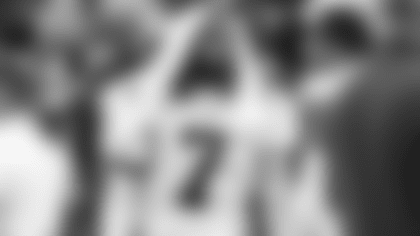SHELTERED IN PLACE, Texas – Sometimes things are just meant to be.
Think about it: Life can be that way, those times we all qualify the turnout with, well, maybe this all happened for a reason.
Football can be that way, too. Especially when it comes to the NFL Draft, the next one under entirely different circumstances and procedures but a week away.
Thirty years ago this coming Wednesday, April 22, 1990, with the 17th pick in the NFL Draft, the Dallas Cowboys, those once mighty Dallas Cowboys coming off four consecutive losing seasons from 1986-89 (7-9, 7-8, 3-13 and 1-15), selected Emmitt Smith, running back, University of Florida.
Over the next 13 seasons with the Cowboys, this kid from Pensacola, Fla., by way of Escambia High School, would become the NFL's all-time leading rusher, his final 18,355-yard total expanded after two final years in the NFL with the Arizona Cardinals, those yards more than the royal likes of Walter Payton, Jim Brown, Steve Van Buren, Clark Hinkle and Cliff Battles, the previous NFL career leaders from 1937 on.
Emmitt is also the NFL's career leader with 164 rushing touchdowns and his 175 total touchdowns are second to only Jerry Rice's 208.
He would help the Cowboys win three Super Bowls and was named the Super Bowl XXVIII MVP, of course churning his way into the franchise's famed Ring of Honor.
What foresight these Dallas Cowboys must have had in 1990, and what coincidental symmetry that in this the 2020 draft, almost 30 years later to the date, the Cowboys once again have the 17th pick in the first round, spurring hope Pro Football Hall of Famers likewise can be found with pick No. 17 again since the Cowboys also selected Hall of Fame defensive back Mel Renfro with the 17th pick in the 1964 draft, though a second-rounder at that time.
But now for the rest of the story:
How Emmitt James Smith III, son of Mary and James Smith Jr., landed in Dallas that April day, coming off the private flight wearing that polka-dotted, shorts jump-suit of sorts, unknowingly taking his first steps into fame and fortune.
And by the end of the story, you're going to say to yourself, man, those Dallas Cowboys, what lucky dogs they are, because the what-ifs will make your head swim
We can start right here. Remember, Smith applied for the draft after his junior year, so what if he had decided to play a fourth season with the Gators?
What if the Cowboys hadn't decided to spend their 1990 first-round draft choice in the 1989 supplemental draft on quarterback Steve Walsh? Then after going 1-15 that 1989 season, the Cowboys would have owned the very first pick in the draft. Instead it was Atlanta, trading the top pick and a fourth-rounder to the Indianapolis Colts for six-time Pro Bowl offensive tackle Chris Hinton, wide receiver Andre Rison (1989 first-round pick) and their 1991 first-round selection (eventually 13th overall).
The Colts then selected Illinois quarterback Jeff George.
Then, too, what if the Cowboys had not traded away Herschel Walker to Minnesota during the 1989 season for a slew of what turned out to be Vikings' draft choices? They would not have then owned the Vikings first-round pick in 1990, the 21st overall selection.
Since the Cowboys already had selected Troy Aikman with the top pick in 1989, they certainly would have been willing to swing a trade with some team had they owned the 1990 top pick. In fact, leading up to the draft, the Cowboys were trying to work their way back into the top five with now their top two picks, 21st in the first round and top pick in the second, so they could take Jimmy Johnson's University of Miami star defensive tackle Cortez Kennedy. But the asking price of two firsts was too steep to move.
In fact, three days before the draft, the Cowboys covered themselves at the running back spot by trading a second- and third- round pick to San Francisco for little-used former 1987 first-round running back Terrence Flagler and Jimmy's former Miami defensive end Daniel Stubbs, plus a Niners third round and 11th round pick.
But even at that time, the Cowboys still were trying to move, pro personnel director John Wooten telling me two days before the draft for the Dallas Times Herald, "We have put out some feelers about moving up."
And then there was this from Cowboys scouting director Dick Mansperger on Baylor linebacker James Francis, considered by many a top-10 talent: "He's a can't miss if that's a possibility. I would like to have him not miss here."
Now then, what if the Cowboys then were able to swing that deal with the Raiders, wanting to send their 21st and 26th picks for the Raiders' 11th and 37th so they could select Francis? But at the last minute the Raiders also wanted a 1991 third-rounder.
Cowboys said no deal.
Still, the Cowboys found a trade partner with Kansas City at No. 13, at the cost of just trading places in the first and second rounds. The deal was contingent on Francis still being available at 13.
So what if Cincinnati had not taken Francis at No. 12?
Or, what if the Bengals had agreed to swing a deal for Francis when the undaunted Cowboys still in pursuit of the linebacker immediately began calling that draft day? Instead, the Bengals basically said, naw, we're happy with what we did.
So there the Cowboys still were at 21, knowing they needed defensive help, but discovering as the drafted moved along that 12 of the first 16 picks in the first round were defensive players, seriously depleting the stock of talent.
But to that point, only one running back had been drafted, the New York Jets at No. 2 selecting Penn State's Blair Thomas. And in a 12-round draft where 45 running backs were selected, a run on running backs was about to commence.
And, of all things, one Emmitt Smith, considered the second-best back in the draft, was still on the board, and as it turned out, the Cowboys had him rated the fourth best player in the draft. But they also figured the likes of Green Bay at 19 and Atlanta at 20 were in the running back market. They also feared the Giants or Niners might leap-frog them for a running back.
And get this, even though the Cowboys had traded for Flagler, in our final Times Herald mock draft, at No. 21 my pick for the Cowboys was Georgia running back Rodney Hampton.
So for the Cowboys, if they wanted what they wanted, it was time to move. Now.
That's when Wooten got on the phone with his contacts in Pittsburgh, the Steelers owning the 17th pick with the first round nearing mid-stream. Wooten's pre-draft reconnaissance revealed the Steelers wanting a tight end, probably Eric Green. So the Cowboys talked trade smack with the Steelers.
Bringing us to yet another what-if.
What if the Cowboys couldn't swing that trade with the Steelers, swapping spots in the first round and giving the Steelers one of their extra thirds? Would Emmitt still have been there at 21? Then what?
But again, maybe things do work out for that mysterious reason. The Cowboys did consecrate that trade with the Steelers, and no matter they had traded a third for Flagler prior to the draft to cover themselves at a vacant running back position, the Cowboys still were in the market for, in their minds, the running back, and after all that, the guy rated as the second best in the draft was looking right at 'em.
Guess we could say the Cowboys basically settled on drafting Emmitt Smith, who simply fell out of the sky right into their laps.
And it's a darn good thing they did make the trade up. Because at 19, the Packers took running back Darrell Thompson. At 20, the Falcons took running back Steve Broussard. At 24, the Giants nabbed Hampton. And at 24, the Niners selected running back Dexter Carter, four running backs gone within the six picks after Emmitt.
In fact, as the story goes, it was Cowboys veteran scout Walt Yaworsky, never one to hide his opinions, jumping up on the table, pounding the darn thing at that, imploring that this Emmitt Smith was the real deal. That ya'll would be crazy to draft anyone else at any position other than Smith.
In fact, story goes that this was the last line in Walt's scouting report on Emmitt:
"Emmitt Smith will someday make Cowboys fans forget about Tony Dorsett."
Yes, the Cowboys did listen to the salty Yaworsky, taking Emmitt Smith. And the rest is history.
And the Steelers? They got their tight end Green at 21.
Never will forget Cowboys running backs coach Joe Brodsky, rest his soul, answering the question that draft day about why select yet another running back when you just traded a third for Flagler.
"Emmitt will take your breath away and you might not get it back until he goes down or scores," Brodsky, the one-time successful Florida high school football coach and Johnson assistant at Miami, said with confidence and obviously with incredible foresight. "Flagler takes your breath away but you get it right back."
Flagler never got the chance. Come Sept. 2, Flagler was waived, much to his dismay.
Come Sept. 4, Emmitt finally signed his contract after missing the entire training camp and preseason during a contentious negotiation with his agents, joining the team that Tuesday before the Sunday, Sept. 9 season opener against San Diego, with 48,063 witnessing a 17-14 Cowboys victory at Texas Stadium, representing the smallest crowd at a home Cowboys game in now the past 30 seasons.
The Cowboys were off and running that year, improving to 7-9, winning just two less than the nine non-strike games they had won over the previous three seasons, and of all things following that 1-15 season, missing the playoffs by one game.
So, too, was Emmitt Smith off … and running mightily, right into the Pro Football Hall of Fame and NFL history.
A year or so later when asking Jimmy what he would have done if unable to trade up for Emmitt and his now coveted running back no longer was on the board at 21, Johnson said, without hesitation, "Rodney Hampton."
Not a bad choice, Hampton spending eight seasons with the Giants, earning two Pro Bowls and finishing with 6,897 career rushing yards and 49 touchdowns, better careers stats than all those other first-round backs. But he was no Emmitt Smith.
And so, now you know the rest of that story, how Emmitt Smith became a Dallas Cowboy.
Those lucky dogs.







